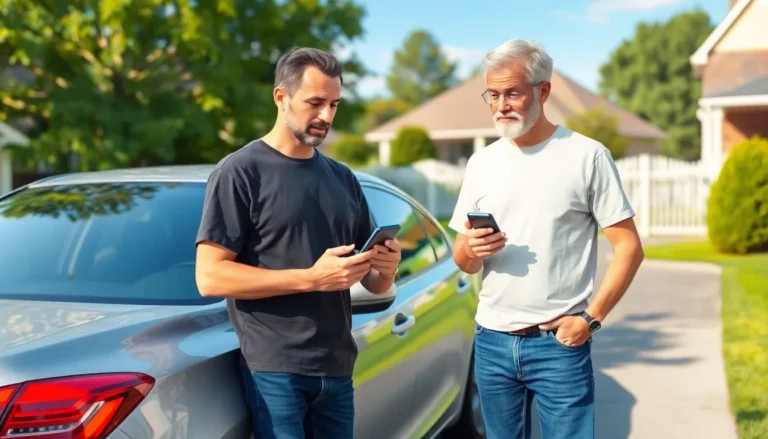Table of Contents
ToggleBuying a car can feel like navigating a maze blindfolded. With all the jargon flying around, it’s easy to get lost. One burning question often pops up: does a down payment actually go towards the car? Spoiler alert: it does! But let’s unpack that little nugget of wisdom before you start daydreaming about your shiny new ride.
Understanding Down Payments
A down payment contributes directly to the car’s purchase price. Understanding its function helps buyers make informed decisions.
What Is a Down Payment?
A down payment represents an initial cash contribution towards a vehicle’s purchase. Often expressed as a percentage of the car’s total price, it reduces the amount financed. Buyers typically negotiate the amount, with 10 to 20 percent being common benchmarks. For example, on a $20,000 car, a 10 percent down payment equals $2,000. Making this upfront payment signals commitment to the deal while lowering future monthly payments.
Importance of a Down Payment
A down payment plays a critical role in securing favorable financing terms. Making a substantial down payment often leads to lower interest rates. This reduction can save buyers thousands in the long run. Additionally, it decreases the overall loan amount, aiding in budget management. Financial institutions view larger payments favorably, increasing the chances of loan approval. In turn, the buyer builds equity in the vehicle from the onset, which can be beneficial during a potential resale.
How Down Payments Work

A down payment plays a crucial role in the car buying process. It serves as an upfront cash contribution that applies directly toward the vehicle’s purchase price.
Application Towards the Car Purchase
Typically, the down payment reduces the total balance owed on the car. A down payment commonly ranges from 10 to 20 percent of the car’s total price. For instance, if a car costs $30,000, a 10 percent down payment equates to $3,000. This amount directly decreases the financing needed, making the payment process smoother for buyers. Buyers show commitment through the down payment, which reassures dealerships and lenders that they are serious about the purchase. This immediate payment enhances negotiations, often resulting in better deals or discounts on the vehicle.
Impact on Loan Amount
The loan amount decreases significantly when a buyer makes a down payment. With reduced financing requirements, monthly payments can also become more manageable. Lenders often view a larger down payment as a sign of lower risk, which can lead to better interest rates. A buyer who puts down $5,000 on a $25,000 car only finances $20,000. Lower loan amounts lead to lower overall interest costs over time. Consequently, down payments allow buyers to budget more effectively, facilitating cheaper payments and less financial strain throughout the loan period.
Common Myths
Misunderstandings often surround down payments. Many believe they’re merely an extra fee, while they actually reduce the car’s total purchase price.
Misconceptions About Down Payments
Some people think a down payment only applies to new cars. This belief disregards its importance for both new and used vehicles. Others may assume that a down payment guarantees loan approval. A down payment improves approval chances but doesn’t guarantee it. Additionally, some believe larger down payments eliminate the need for car insurance. This notion is incorrect; insurance is always necessary regardless of payment size.
Clarifying the Truth
A down payment decreases the financed amount, enhancing affordability. For instance, putting down $3,000 on a $30,000 vehicle reduces financial responsibility significantly. Certain buyers think they can skip the down payment altogether, which often leads to higher monthly payments and interest costs. Ultimately, making a down payment typically results in favorable financing terms, lowering stress while managing budgets. Down payments matter; buyers who grasp this concept navigate the car buying process more effectively.
Benefits of Making a Down Payment
A down payment offers significant advantages in the car buying process. It enhances affordability and financial stability for buyers.
Lower Monthly Payments
Lower monthly payments result from making a down payment. By contributing a percentage of the car’s price upfront, buyers reduce the total amount financed. For instance, on a $30,000 vehicle with a 10 percent down payment, buyers pay $3,000 upfront. This reduction leads directly to smaller monthly payments, easing financial strain. Furthermore, lower payment amounts promote flexibility in budgeting. Buyers often benefit from less financial pressure throughout the loan term. This financial relief can free up funds for other essential expenses.
Improved Loan Approval Chances
Improved loan approval chances stem from a larger down payment. Lenders view a substantial initial payment as a sign of commitment and reduced risk. Higher down payments can also result in better loan terms. For example, buyers making a significant down payment may secure lower interest rates. Lower interest rates further reduce total loan costs, increasing overall affordability. Additionally, larger deposits convey financial responsibility, potentially leading to a higher likelihood of approval. Buyers can navigate the financing process with more confidence by enhancing their chances for favorable terms.
Understanding the role of a down payment in the car buying process is crucial for any potential buyer. It not only reduces the total amount financed but also paves the way for better financing options. By making a substantial down payment, buyers can enjoy lower monthly payments and improved loan approval chances.
This initial investment reflects a commitment to the purchase and can significantly enhance the overall car buying experience. Ultimately, a well-planned down payment strategy can lead to greater financial stability and peace of mind throughout the loan period.







